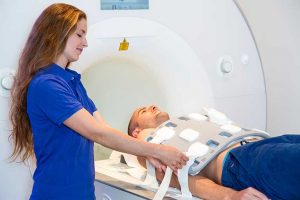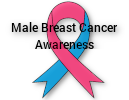
Breast cancer treatment options are the same for men as they are for women, and treatments exist for every type and stage of breast cancer. Although some men may only need surgery, many others will need surgery and additional treatment, such as radiation or chemotherapy. Talk to your health care team in order to find the best treatment option(s) for you.
Male breast cancer treatments include:
- Surgery
Men usually do not have the option for breast-sparing surgery like women. Men have very little tissue underneath the nipple, and most of the tissue must be removed in order to remove the cancer.- Simple Mastectomy
A surgeon removes all of the breast tissue, including the lobules, ducts, fatty tissue, and a strip of skin with the nipple and areola. Additional treatment may be needed depending on the results of the operation. - Modified Radical Mastectomy
Most male breast cancer patients require a modified radical mastectomy. Here, a surgeon removes your entire breast and some underarm (auxiliary) lymph nodes but leaves your chest muscles intact. If the cancer has spread into the chest wall, a surgeon may need to perform a radical mastectomy which also removes the chest wall muscles. After surgery, the lymph nodes will be tested to see if the cancer has spread, and further treatment may be necessary depending on the results. - Sentinel Lymph Node Biopsy
Breast cancer first spreads to the lymph nodes under the arms. In the past, surgeons would try to remove every lymph nodes possible, but removing all lymph nodes greatly increased the risk of numbness, recurrent infections, and serious swelling of the arm. A procedure has been developed to find the sentinel nodes, the first nodes to receive the drainage from breast tumors and therefore the first to develop cancer. If a sentinel node is removed, examined, and found to be healthy, the chance of finding cancer in any of the remaining nodes is very small, and no other nodes need to be removed. Removal of a single node for examination spares the need for a more extensive operation and greatly decreases the risk of complications. A sentinel lymph node biopsy should be performed by a team experienced with the procedure.
- Simple Mastectomy
- Radiation Therapy
Radiation therapy uses high-energy X-rays to kill cancer cells and shrink tumors and is administered by a radiation oncologist at a radiation center. The therapy is used to shrink the tumor before surgery or eliminate any remaining cancer cells in the breast, chest muscles, or armpit after surgery. Most men who undergo radiation therapy receive external beam radiation, in which a machine outside the body administers the radiation. The treatment usually starts three or four weeks after surgery, and lasts five days a week for five or six consecutive weeks. Radiation is painless and is similar to getting an X-ray, but the effects are cumulative. Most men become quite tired toward the end of the series, and the breast may be pink, puffy, and tender, similar to a sunburn. - Chemotherapy
Chemotherapy uses drugs to destroy cancer cells, and doctors often recommend chemotherapy after surgery to kill any cancer cells that may have spread outside the breast. Treatment can involve two or more drugs in different combinations that may be administered intravenously, in pill form or both. The treatments usually occur every two or three weeks for three to six months.Certain chemotherapies target the cancer itself which may minimize damage to healthy cells. These therapies also may help reduce side effects such as nausea and vomiting that accompany standard chemotherapy. There are also therapies that provide choices to patients in terms of method of delivery and timing. Depending upon the type and stage of their breast cancer, some patients have the option of taking chemotherapy in a pill form, rather than intravenously (administered through a vein); patients taking oral chemotherapy may find it more convenient because they can take it at home, work or while traveling, and spend less time at the clinic or hospital.Some chemotherapy treatment regimens can feel like another illness, and side effects include hair loss, nausea, vomiting, and fatigue. The side effects can be more difficult to manage because chemotherapy affects healthy cells, especially fast-growing cells in the digestive tract, hair and bone marrow, as well as cancerous cells. Not everyone has side effects, and there are treatments available to help reduce or control some of them. Additionally, “chemobrain,” the common term for cognitive changes that occur during and after cancer treatment, may also occur; chemotherapy can affect your cognitive abilities by word searching during conversation, short-term memory lapses, difficulty multi-tasking, slower learning, and slower processing speed. - Hormone Therapy
In estrogen receptor positive cancer, estrogen may encourage the growth of cancerous breast cells. Although men have lower levels of estrogen than women, 75% of male breast cancers have estrogen receptors. Hormone medication can be administered in order to prevent estrogen from bonding to certain sites in the breast and other parts of the body, thus helping destroy cancer cells that have spread or reducing the chances that cancer will recur. Male hormones, androgens, also play a role in the growth of breast cancer, and limiting androgens using hormone therapy appears to effectively reduce the spread of cancer. - Biological Therapy
Biological therapy, also known as biological response modifier or immunotherapy, tries to stimulate the body’s immune system to fight cancer. In the treatment, the use of substances produced by the body or similar substances made in a laboratory seeks to enhance the body’s natural defenses against specific diseases. Many biological therapies are experimental and are only available in clinical trials.
